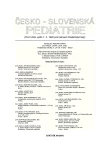The Effects of Physical Activity on Blood Lipids and Lipoproteins in Children
Authors:
M. Máček
Authors‘ workplace:
Klinika rehabilitace 2. LF UK a FN Motol, Praha
přednosta doc. PaedDr. P. Kolář
Published in:
Čes-slov Pediat 2005; 60 (6): 379-384.
Category:
Original Papers
Overview
Cardiovascular disease (CHD) due to atherosclerosis remains one of the leading causes of morbidity and mortality in developed countries. The therapy of CHD costs the national economies an estimated giant amouts of tax money, but the money spent for the prevention, where the physical activity plays an important role, only 1% is used. Because the first markers of the disease can be found during the childhood, numerous studies focused on the effect of regular exercise on the paediatric lipoprotein profile were provided. The optimal solution of primary prevention is wanted, where physical activity and sports training could be decisive. An inverse relationship between aerobic fitness and CHD has been confirmed in adults, but the similar association is not as easily verified for children and adolescents. The actual studies have brought only ambiguous results.
Key words:
physical activity, prevention, children. blood lipids, metabolic adaptation
Labels
Neonatology Paediatrics General practitioner for children and adolescentsArticle was published in
Czech-Slovak Pediatrics

2005 Issue 6
Most read in this issue
- Relation of Sexual and Skeletal Maturity Assessment to Biological Age in Pediatric Practice
- Growth and Final Height in Girls with Central Precocious Puberty after Long-term Treatment with Depot Gonadoliberin Analogue
- Prediction and Prevention of Type 1 Diabetes Mellitus
- Homozygous Form of Familial Defect of Apo B-100 (FDB) in a 7-Year Girl
